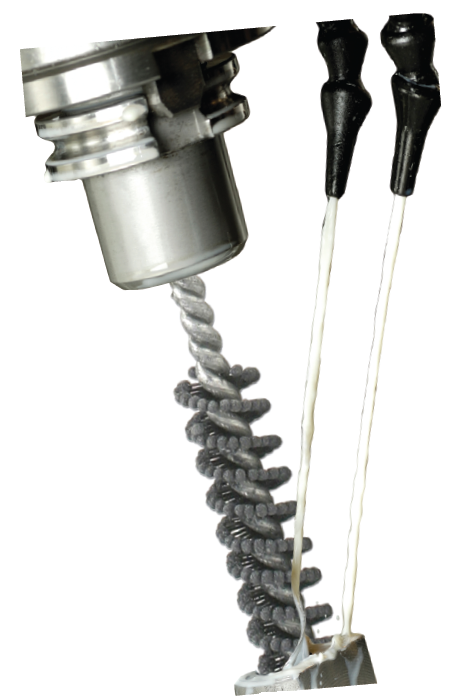- FMA
- The Fabricator
- FABTECH
- Canadian Metalworking
Hard parts, fine finishes at Sikorsky
Carburized surfaces present a unique problem to manufacturers in close tolerance industries — Sikorsky shows just how it deals achieves a smooth finish for bearing components, shafts, sleeves and bores.
- By Canadian Metalworking
- June 27, 2014
- Article
- Metalworking
Carburized surfaces present a unique problem to manufacturers in close tolerance industries …they’re hard and often coated in a scale that must be removed to achieve a smooth finish for bearing components, shafts, sleeves and bores.
At Sikorsky Helicopter, a carburized bearing surface delivered by a supplier was coated with scale and required a very smooth finish. “We attempted to remove this scale with a carbide reamer and a diamond lap - to no avail,” says Tony Lawrence, Tooling Services Manager for Sikorsky Product Center Core Services.
“The material in question was 9310 [alloy steel], and very hard, around 66RC,” Lawrence explains, which required a tool of equal toughness to do the job properly. He notes that his group had used diamond Flex-Hones, available from Brush Research Manufacturing in a very limited set of applications previously, but not for this high volume situation.
The Flex-Hone is a ball-style tool characterized by a shaft with small, abrasive globules that are permanently mounted to flexible filaments. The tool, which can be mounted in a hand drill motor or a machine tool chuck, is used for finishing or resurfacing of the hard metals, ceramics and other tough materials used in items such as ports, sleeves, and cylindrical bores. Quite often the flexible hone is used instead of cumbersome conventional equipment such as CNC-based hones and anvil tools.
The flexible hone is available in many sizes with a wide selection of grit material, allowing the tool to be matched with a variety of materials from very hard, heat treated alloys to softer, non-ferrous. Custom sizes and grits are also available directly from the manufacturer.
In the case of Sikorsky, the flexible hone needed to be constructed with diamond crystal grit. Brush Research offers a diamond flex-hone in a variety of mesh sizes that can easily produce finishes on hard materials to a range of Ra of 0.1 to 0.15μm.
“So now that we had the first success, we were going to need to produce thousands of these [flexible hones], since we were at a production stop,” he continues. “We contacted Brush Research and explained our dilemma. Two days later we had the first production run of brushes and we were able to ship our product again to customers all over the world.”
Grant Fowlie, Brush Research Customer Service Manager, says that “quite often the customer has a pretty good idea of what he is looking for in a flexible hone,” Fowlie explains. “For example, they know the size and hardness of the material they are dealing with and may even the kind of honing grit required. In cases like those we may simply send one or two standard hones so they can see how the tools work for their application.”
Fowlie adds that in other cases his team requests samples of the material to be honed and then performs tests on site using sophisticated surface analysis equipment to ensure that the company’s recommendations are well founded.
“Surface finish analysis will give you roughness [Ra] and a variety of other measurements as far as surface finishing analysis goes, including peak height, valley depth, bearing areas and other specifications that have their own importance in different applications,” says Fowlie.
Fowlie points out that the Flex-Hone is well suited to numerous aerospace applications, ranging from very small to quite large.
“We produce very slender hones for tiny IDs, but also produce tools for use on large jet engines that required hones 10-15-inches in diameter.”
The Flex-Hone is also in wide use throughout many other industries, including automotive, firearms, machine shops and other types of manufacturing.
About the Author
subscribe now


Keep up to date with the latest news, events, and technology for all things metal from our pair of monthly magazines written specifically for Canadian manufacturers!
Start Your Free Subscription- Trending Articles
Automating additive manufacturing

Sustainability Analyzer Tool helps users measure and reduce carbon footprint

CTMA launches another round of Career-Ready program

Sandvik Coromant hosts workforce development event empowering young women in manufacturing

GF Machining Solutions names managing director and head of market region North and Central Americas

- Industry Events
MME Winnipeg
- April 30, 2024
- Winnipeg, ON Canada
CTMA Economic Uncertainty: Helping You Navigate Windsor Seminar
- April 30, 2024
- Windsor, ON Canada
CTMA Economic Uncertainty: Helping You Navigate Kitchener Seminar
- May 2, 2024
- Kitchener, ON Canada
Automate 2024
- May 6 - 9, 2024
- Chicago, IL
ANCA Open House
- May 7 - 8, 2024
- Wixom, MI

















